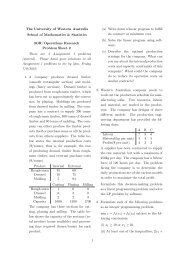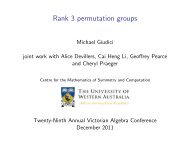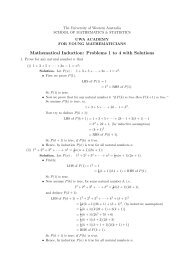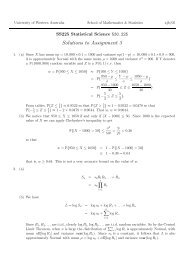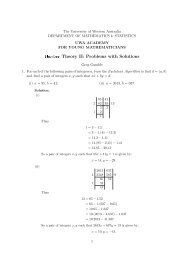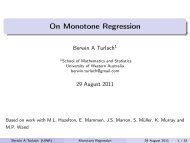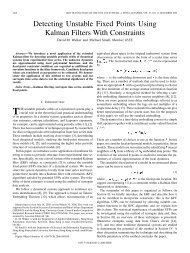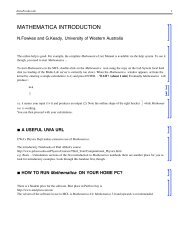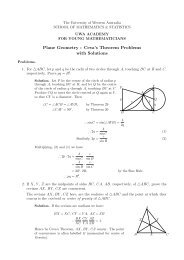The Blakers Mathematics Contest 2003 Problems and Solutions 1 ...
The Blakers Mathematics Contest 2003 Problems and Solutions 1 ...
The Blakers Mathematics Contest 2003 Problems and Solutions 1 ...
You also want an ePaper? Increase the reach of your titles
YUMPU automatically turns print PDFs into web optimized ePapers that Google loves.
<strong>The</strong> <strong>Blakers</strong> <strong>Mathematics</strong> <strong>Contest</strong> <strong>2003</strong><strong>Problems</strong> <strong>and</strong> <strong>Solutions</strong>1. An interesting sequenceFor n ≥ 1, defineH n = 1 n + 1n + 3 + 1n + 6 + · · · + 1n + 3(n − 1)Prove that {H n } converges <strong>and</strong> find its limit. [Hint: Consider Riemannsums.]Solution (Shane Kelly, 2nd year, UWA)Consider the function f(x) = 11 + 3xAn upper Riemann sum for f(x) over [0, 1] with interval size 1/n isHencen∑( ) 1 1n∑fn n =i=1lim n→∞so lim n→∞ H n = ln 43 .i=1i=1= H n − 1 n2. Range of a polynomial1n + 3i =0n∑i=11n + 3(i − 1) − 1 nn∑( ∫ 1 1 1fn)n = 1 ln 4dx =1 + 3x 3 ,What are all the possible values of solutions to x 2 + px + q = 0, wherep <strong>and</strong> q can take on any values in the interval [−1, 1]?Solution (Shreya Bhattarai, 2nd Year, UWA)By the fundamental theorem of algebra, x 2 + px + q = (x − z)(x − w)where z, w ∈ C. Since the cofficients p, q ∈ R, z <strong>and</strong> w have complexpart conjugate, say z = a + bi <strong>and</strong> w = c − bi.<strong>The</strong>n p = a + c ∈ [−1, 1] <strong>and</strong> q = ac − b 2 ∈ [−1, 1]. Furthermore,by continuity of polynomials <strong>and</strong> the Intermediate Value <strong>The</strong>orem, allvalues satisfying these bounds can be attained.Case 1 b = 0: We need the values of a for which a + c ∈ [−1, 1] <strong>and</strong>ac ∈ [−1, 1] for some c. Note that for c = 0, any a ∈ [−1, 1] satisfies1
We are trying to prove that1n∑k rot θ (P i − P i−1 ) = 0,ni=1that is, the displacement vector of the centre of mass is zero. Sinceinitially the dogs form a closed circle we can assumen∑(P i − P i−1 ) = 0,i=1where P 0 means P n .Since rotation <strong>and</strong> scaling fix the zero vector,n∑n∑krot θ (P i − P i−1 ) = krot θ (P i − P i−1 ) = 0,i=1i=1so 1 n∑ ni=1 krot θ(P i − P i−1 ) = 0, so the centre of mass does not change.
4. Logical paradoxA well–known logical joke is a card saying on one side ”<strong>The</strong> statementon the other side is false” <strong>and</strong> on the other, ”<strong>The</strong> statement on theother side is true”. Clearly, it is impossible for either of the statementsto be true or false without leading to an inconsistency. However, ifboth sides said ”<strong>The</strong> statement on the other side is false” or ”<strong>The</strong>statement on the other side is true”, it is possible for these statementsto be logically consistent.Now suppose you are given a stack of n cards, each of which says either”<strong>The</strong> statement on the next card is false” or ”<strong>The</strong> statement on thenext card is true”. Is it possible to arrange the cards into an orderwhich makes the whole pack logically consistent?SolutionWe assume that the last card in an arrangement refers to the firstcard. We are going to show that regardless of the order, the cards canbe logically consistent if <strong>and</strong> only if the number of cards which statethat the next card is false is even.Suppose we have the deck of cards together with some consistent assignmentof truth value to each card. Label each card by T if it saysthat the statement on the next card is true, <strong>and</strong> by F if it says thatthe statement on the next card is false. Also label each card by t if itis true, <strong>and</strong> by f if it is false. Thus each card has one of the labels Tt,Tf, Ft, or Ff.We first show that any card labelled T can be removed from the deckwithout altering the remaining labels. If it is labelled Tt, the precedingcard must be either Tt or Ff <strong>and</strong> the next card must be either Tt orFt. Thus removing the given Tt card does not change anything in therest. If it is labelled Tf, then the preceding card must be labelled Tf orFt <strong>and</strong> next card must be either Ft or Ff. Once again, removing thegiven Tf card does not change the rest.Hence we now assume that the remaining cards are all labelled Ft orFf. Next we show that removing a pair of adjacent F cards does notalter the remaining labels. First note that a pair (Ft, Ft) cannot beconsistent, since Ft truthfully claims that the statement on the nextcard is false. Similarly, (Ff, Ff) cannot be consistent, since Ff falselyclaims that the statement on the next card is false, so that statementmust be true. Hence any adjacent pair must be (Ft, Ff), in which casethe preceding card is Ff <strong>and</strong> the next card is Ft; or (Ff, Ft) in whichcase the preceding card is Ft <strong>and</strong> the next card is Ff. In both cases,the pair can be removed.
Thus we finally reach a pair (Ft, Ff) or (Ff, Ft) which are consistent, ora single Ft or Ff which corresponds to ‘<strong>The</strong> statement on the other sideis false’ which is inconsistent, a contradiction. Hence the original deckwas consistent if there are an even number of F cards, <strong>and</strong> inconsistentif there are an odd number.5. Average distanceLet [0, 1] be be the unit interval. If X = {x 1 , x 2 , . . . , x n } is an n–tupleof points in [0, 1] <strong>and</strong> t is any point in [0, 1], the average distanceD(t, X) from t to X is defined to be 1 n∑|t − x i |.nProve that for any choice of n > 1 <strong>and</strong> X in [0, 1], there exists t ∈ [0, 1]such that D(t, X) = 1 2 . Show also that 1 is the only distance for which2this result is true.Now show that if [0, 1] is replaced by an equilateral triangle of side 1,<strong>and</strong> all distances are measured along the sides of the triangle, then thesame results are true with 1 2 replaced by 2 + √ 3.6(Apologies from the setters. <strong>The</strong> second part should have stated thatthe n–tuple of points lie on the sides of an equilateral triangle, but thedistances measured are ordinary Euclidean distances in the plane)1Solution (Michael Pauley, 2nd Year, UWA)Since all the numbers in X lie betrween 0 <strong>and</strong> 1, so does their average,A. If A ≤ 1, then the average of {(1 − x 2 i)} ≥ 1 <strong>and</strong> vice versa. So2either D(0, X) ≤ 1 <strong>and</strong> D(1, X) ≥ 1 or vice versa. Since D(t, X) is2 2a continuous function of t, by the Intermediate Value <strong>The</strong>orem thereexists t such that D(t, X) = 1.2To see that 1 is the only possibility for all choices of X, let X = {0, 1};2in this case D(t, X) = 1 for all t ∈ [0, 1].2When we replace the interval by an equilateral triangle of side 1, theaverage distance function is still continuous. Taking X to be the threevertices <strong>and</strong> the three side midpoints, we see that D(t, X) ≤ 2 + √ 36at some point <strong>and</strong> D(t, X) ≥ 2 + √ 3at some point, <strong>and</strong> hence by the6IVT attains this value at some t.
To see that this is the only possibility, for any d ≠ 2 + √ 3, place6enough points t regularly around the triangle so that the average distanceD(t, X) ≠ d.6. Coin tossTwo fair coins are tossed simultaneously until at least one of the twoshows a head. If only one of the two is a head, the other is tossed untilit turns up head. What is the expected number of tosses to get headson both the coins?Solution (Shreya Bhattarai, 2nd Year, UWA)Let E(2) be the expected number of tosses to finish the game <strong>and</strong> E(1)the expected number to toss one head.<strong>The</strong>n E(2) = 1 + 1(E(2)) + 1 (E(1)), where the first term represents4 2the current toss, the second a toss of {T, T }, <strong>and</strong> the third a toss of{T, H}.Since E(1) = 1 + 1 (E(1)) we see that E(1) = 2 <strong>and</strong> hence E(2) =22 + 1(E(2)), from which E(2) = 8.4 37. Maximise the product(a) Given a positive integer n, find a finite sequence (a 1 , a 2 , . . . , a m ) ofpositive integers whose sum is n <strong>and</strong> whose product is maximal.(b) Now try the same problem with ‘integer’ replaced by ‘real number’.Solution (Shreya Bhattarai, 2nd year, UWA)(a) Let a i + · · · + a k = n > 1. If any a i ≥ 4, we do not decrease theproduct by replacing a i by (a i − 2) + 2, so we can assume all the a i are2 or 3. If there are more than two 2’s, we can increase the product byreplacing 2 + 2 + 2 by 3 + 3. Hence the maximum product is obtainedwith zero, one or two 2’s <strong>and</strong> the rest of the terms 3’s.(b) First we show that for a maximum product, all the terms of the summust be equal. Suppose n = x 1 +· · · x k with x i ≠ x j . By the arithmeticgeometricmean inequality,> x i x j so the product can be( ) 2 xi + x j2increased by replacing each by their average.( n) k.Now we have to find the number k which maximises the productkFor this, replace the rational n/k by a continuous variable x <strong>and</strong> considerthe differentiable function f(x) = x n/x .
<strong>The</strong>n( nf ′ (x) =x − n ln x )x n/x = n 2 x 2 x 2 xn/x (1 − ln x)Since f ′ (x) > 0 for x < e <strong>and</strong> f ′ (x) < 0 for x > e, f(x) attains itsmaximum for x = e.So n/k should be close to e for the maximum product. Choose theinteger m such that m < n/e < m + 1 <strong>and</strong> compare (n/m) m <strong>and</strong>(n/m + 1) m+1 . Call m ∗ whichever of m or m + 1 gives the greatervalue. <strong>The</strong>n the required sequence is constant with m ∗ terms of valuen/m ∗ .8. ‘Regression’ lineLet P 1 (x 1 , y 1 ), P 2 (x 2 , y 2 ) <strong>and</strong> P 3 (x 3 , y 3 ) be three points in the plane,with x 1 < x 2 < x 3 . Say that y = Ax + B is a least absolute line if thefunction3∑g(a, b) = |ax i + b − y i |has a minimum at (a, b) = (A, B).Must a least absolute line pass through two of the three points?1Solution Yes. Each line y = ax + b with a ≠ 0 divides the plane intoan upper half plane U ab <strong>and</strong> a lower half plane L ab .For fixed a, g(a, b) is a decreasing function of b when U ab contains twoor three P i in its interior <strong>and</strong> an increasing function of b when L abcontains two or three P i in its interior.So for fixed a, the minimum of g(a, b) occurs when the line y = ax + bcontains a vertex (x r , y r ) of triangle P 1 P 2 P 3 <strong>and</strong> a point on the oppositeside.For the line y = a(x − x r ) + y r containing (x r , y r ), the function3∑g(a, y r − ax r ) = |a(x i − x r ) − (y i − y r )|i=1is a linear function of a if the line does not contain a second vertex.Also lim a→±∞ g(a, y r − ax r ) = ∞.Hence if y = ax+b contains (x r , y r ) then the minimum of g(a, b) occurswhen the line contains a second vertex. A simple geometric argumentshows that the distance from P i to this line is minimised when i = 2.Thus the least absolute line is that containing P 1 <strong>and</strong> P 3 .9. Circulant matrices
A matrix such as ⎡ ⎤2 5 8 9⎢9 2 5 8⎥⎣8 9 2 5⎦5 8 9 2in which each row is obtained by shifting the previous row one stepto the right, with the last entry returning to the beginning, is called acirculant.Prove that the set of n × n circulant matrices with real number entriesis closed under addition <strong>and</strong> multiplication <strong>and</strong> multiplication iscommutative.Show that if a circulant is invertible, then its inverse is a circulant.Solution Let A = (a ij ) <strong>and</strong> B = (b ij ) be circulant matrices, so a ij =a i+1,j+1 (indices taken modulo n). <strong>The</strong>n a ij + b ij = a i+1,j+1 + b i+1,j+1so A + B is circulant.Now AB = (c ij ) where c ij = ∑ k a ikb kj = ∑ k a i+1,k+1b k+1,j+1 = c i+1,j+1 .Hence AB is circulant.Also BA = (d ij ) whered ij = ∑ kb ik a kj = ∑ kb i+(j−k),k+(j−k) a k+(i−k),j+(i−k)= ∑ kb i+j−k,j a i,i+j−k = ∑ ka i,i+j−k b i+j−k,j = c ij .Hence BA = AB.Now suppose A is an invertible circulant with first row (a 1 , a 2 , . . . , a n ).We have to show that there is an n–tuple b = (b 1 , b 2 , . . . , b n ) such thatif B is the circulant with this first row, then AB = 1. <strong>The</strong> first columnof B is also b, so b, if it exists, is the solution of the linear system withaugmented matrix [A|e 1 ], where e 1 is the first st<strong>and</strong>ard basis element.Since A is invertible, b exists (<strong>and</strong> is unique). But then the secondcolumn of B, (b 2 , . . . , b n , b 1 ) is the solution of the linear system withaugmented matrix [A|e 2 ] <strong>and</strong> so on. Hence AB = I n .10. Jumping GorillasA gorilla, of mass 100kg, is imprisoned inside a cage of mass 350kg,which is suspended in mid-air on a long rope thrown over a pulley. Atthe other end of the rope is a counterweight of mass 450kg, exactlybalancing the combined weight of the cage <strong>and</strong> gorilla.Attached to the roof of the cage, on the inside, is a delicious bunchof bananas, which the gorilla would love to eat. Unfortunately they’re
out of his reach, by 10cm. He decides to jump up into the air, just farenough to be able to grab the bananas, then fall back down to the cagefloor.How fast does he need to jump? Specifically, with what speed does thegorilla need to move away from the cage floor?You may assume that g = 10ms −2 .(We acknowledge with thanks the on–line magazine Plus (http://plus.maths.org.uk/)from which this problem was borrowed.)Solution Assume that the rope is light, the pulley frictionless etc. Forconvenience, we can regard the system (cage + counterwieght) as asingle element.In jumping, the gorilla exerts a force internal to the system (gorilla +cage + counterwieght) so in this phase of the motion the centre of massdoes not move.Let the initial velocity of the gorilla upwards be u <strong>and</strong> the initial velocityof the (cage + counterwieght) downwards be U.<strong>The</strong> fixed centre of mass implies 100u = (350 + 450)U, so u = 8U.Choose the origin at the floor of the cage <strong>and</strong> measure displacementsupwards.For the subsequent motion of the gorilla we haveẍ = −gẋ = u − gt, (ẋ(0) = u)x = ut − 1 2 gt2 , (x(0) = 0)<strong>The</strong> subsequent motionof the cage has upwards accelerationdifference of massessum of masses= 1008 g<strong>The</strong>nẌ = g/8Ẋ = −U + gt/8,(Ẋ(0) = −U)X = −Ut + 1 2 gt2 /16, (X(0) = 0)
Distance between gorilla <strong>and</strong> cage=x − X=ut − 1 2 gt2 − (−Ut + gt 2 /16)= 9 8 (ut − 1 2 gt2This attains its maximum when t = u g9 18 2u 2g .so the maximum distance isWe require this distance to be 0.1 m, implying u = 0.1 16g9= 4 3 ,using g = 10ms −2 .<strong>The</strong>n the relative velocity of gorilla <strong>and</strong> cage is u + U = 9u = 8 1.5ms−1 .√



